stop start BMW 5 SERIES 2013 F10 Owner's Guide
[x] Cancel search | Manufacturer: BMW, Model Year: 2013, Model line: 5 SERIES, Model: BMW 5 SERIES 2013 F10Pages: 273, PDF Size: 6.63 MB
Page 122 of 273
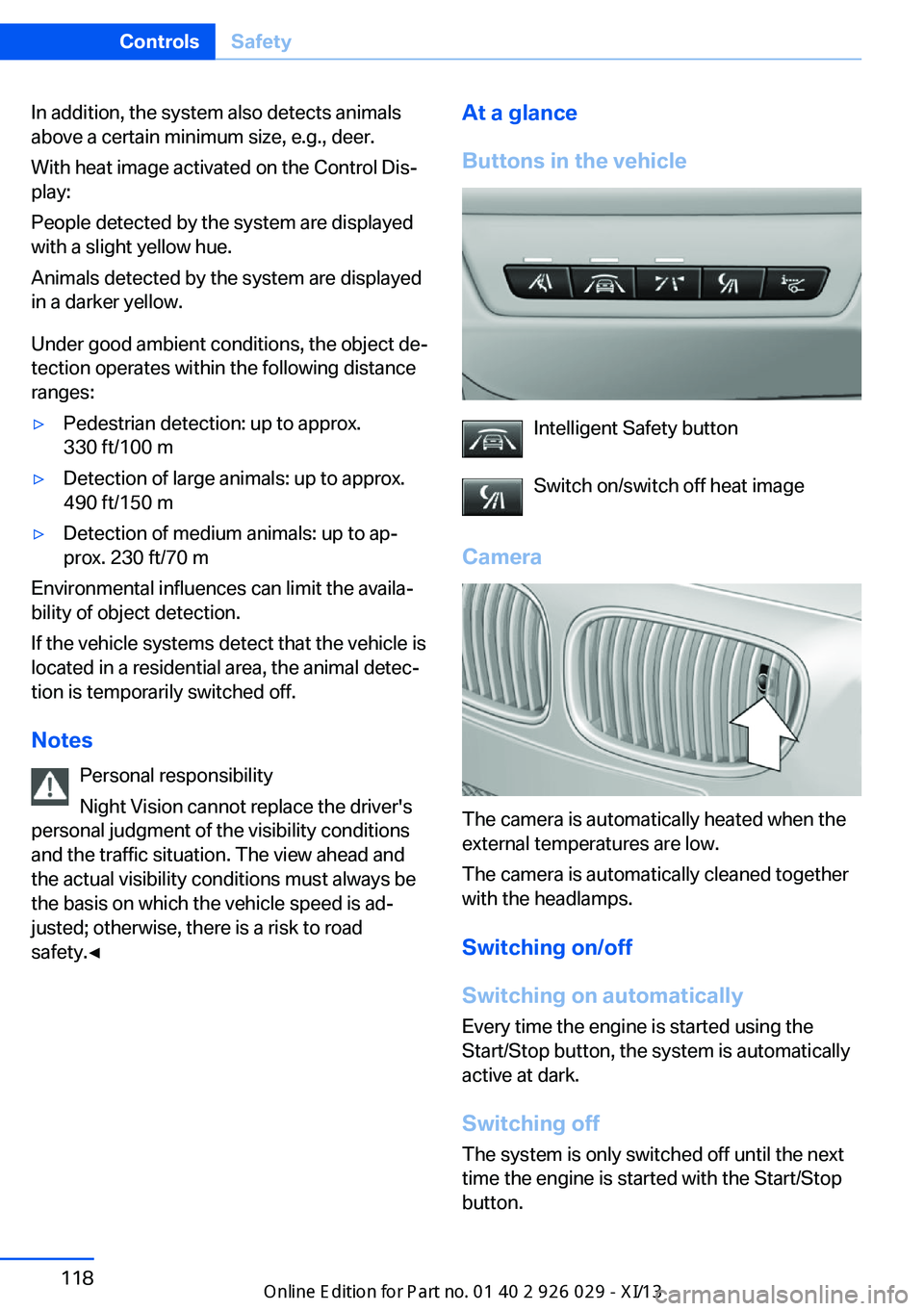
In addition, the system also detects animals
above a certain minimum size, e.g., deer.
With heat image activated on the Control Dis‚Äź
play:
People detected by the system are displayed
with a slight yellow hue.
Animals detected by the system are displayed
in a darker yellow.
Under good ambient conditions, the object de‚Äź
tection operates within the following distance
ranges:‚Ė∑Pedestrian detection: up to approx.
330 ft/100 m‚Ė∑Detection of large animals: up to approx.
490 ft/150 m‚Ė∑Detection of medium animals: up to ap‚Äź
prox. 230 ft/70 m
Environmental influences can limit the availa‚Äź
bility of object detection.
If the vehicle systems detect that the vehicle is
located in a residential area, the animal detec‚Äź
tion is temporarily switched off.
Notes Personal responsibility
Night Vision cannot replace the driver's
personal judgment of the visibility conditions
and the traffic situation. The view ahead and the actual visibility conditions must always be
the basis on which the vehicle speed is ad‚Äź justed; otherwise, there is a risk to road
safety.‚óÄ
At a glance
Buttons in the vehicle
Intelligent Safety button
Switch on/switch off heat image
Camera
The camera is automatically heated when the
external temperatures are low.
The camera is automatically cleaned together
with the headlamps.
Switching on/off
Switching on automatically
Every time the engine is started using the
Start/Stop button, the system is automatically
active at dark.
Switching off The system is only switched off until the next
time the engine is started with the Start/Stop
button.
Seite 118ControlsSafety118
Online Edition for Part no. 01 40 2 911 177 - VI/13
Page 128 of 273
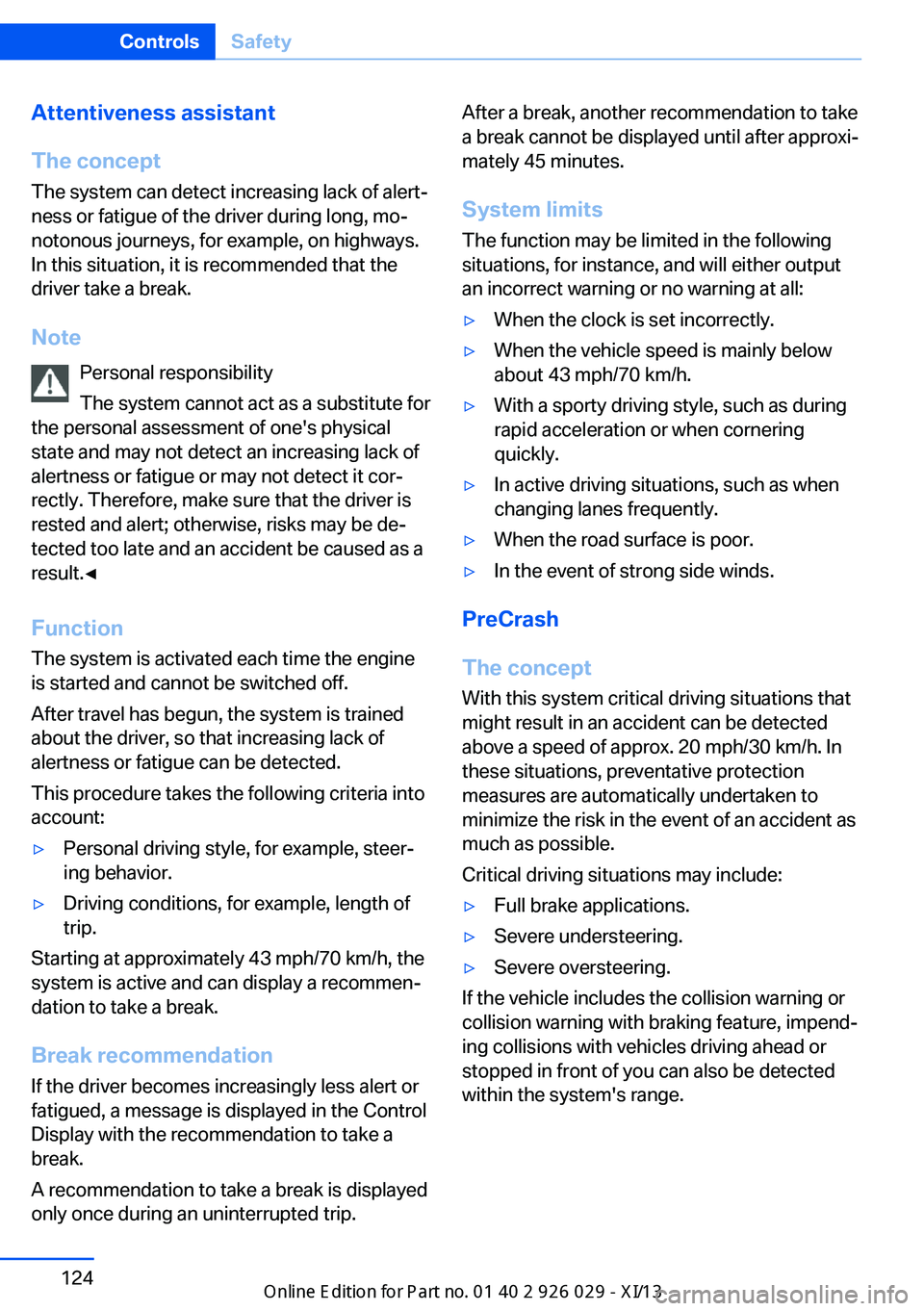
Attentiveness assistant
The concept The system can detect increasing lack of alert‚Äź
ness or fatigue of the driver during long, mo‚Äź
notonous journeys, for example, on highways.
In this situation, it is recommended that the
driver take a break.
Note Personal responsibility
The system cannot act as a substitute for
the personal assessment of one's physical
state and may not detect an increasing lack of
alertness or fatigue or may not detect it cor‚Äź
rectly. Therefore, make sure that the driver is
rested and alert; otherwise, risks may be de‚Äź
tected too late and an accident be caused as a
result.‚óÄ
Function
The system is activated each time the engine
is started and cannot be switched off.
After travel has begun, the system is trained
about the driver, so that increasing lack of
alertness or fatigue can be detected.
This procedure takes the following criteria into
account:‚Ė∑Personal driving style, for example, steer‚Äź
ing behavior.‚Ė∑Driving conditions, for example, length of
trip.
Starting at approximately 43 mph/70 km/h, the
system is active and can display a recommen‚Äź
dation to take a break.
Break recommendation
If the driver becomes increasingly less alert or
fatigued, a message is displayed in the Control
Display with the recommendation to take a
break.
A recommendation to take a break is displayed
only once during an uninterrupted trip.
After a break, another recommendation to take
a break cannot be displayed until after approxi‚Äź
mately 45 minutes.
System limits
The function may be limited in the following
situations, for instance, and will either output
an incorrect warning or no warning at all:‚Ė∑When the clock is set incorrectly.‚Ė∑When the vehicle speed is mainly below
about 43 mph/70 km/h.‚Ė∑With a sporty driving style, such as during
rapid acceleration or when cornering
quickly.‚Ė∑In active driving situations, such as when
changing lanes frequently.‚Ė∑When the road surface is poor.‚Ė∑In the event of strong side winds.
PreCrash
The concept With this system critical driving situations that
might result in an accident can be detected
above a speed of approx. 20 mph/30 km/h. In these situations, preventative protection
measures are automatically undertaken to
minimize the risk in the event of an accident as
much as possible.
Critical driving situations may include:
‚Ė∑Full brake applications.‚Ė∑Severe understeering.‚Ė∑Severe oversteering.
If the vehicle includes the collision warning or
collision warning with braking feature, impend‚Äź
ing collisions with vehicles driving ahead or
stopped in front of you can also be detected
within the system's range.
Seite 124ControlsSafety124
Online Edition for Part no. 01 40 2 911 177 - VI/13
Page 130 of 273
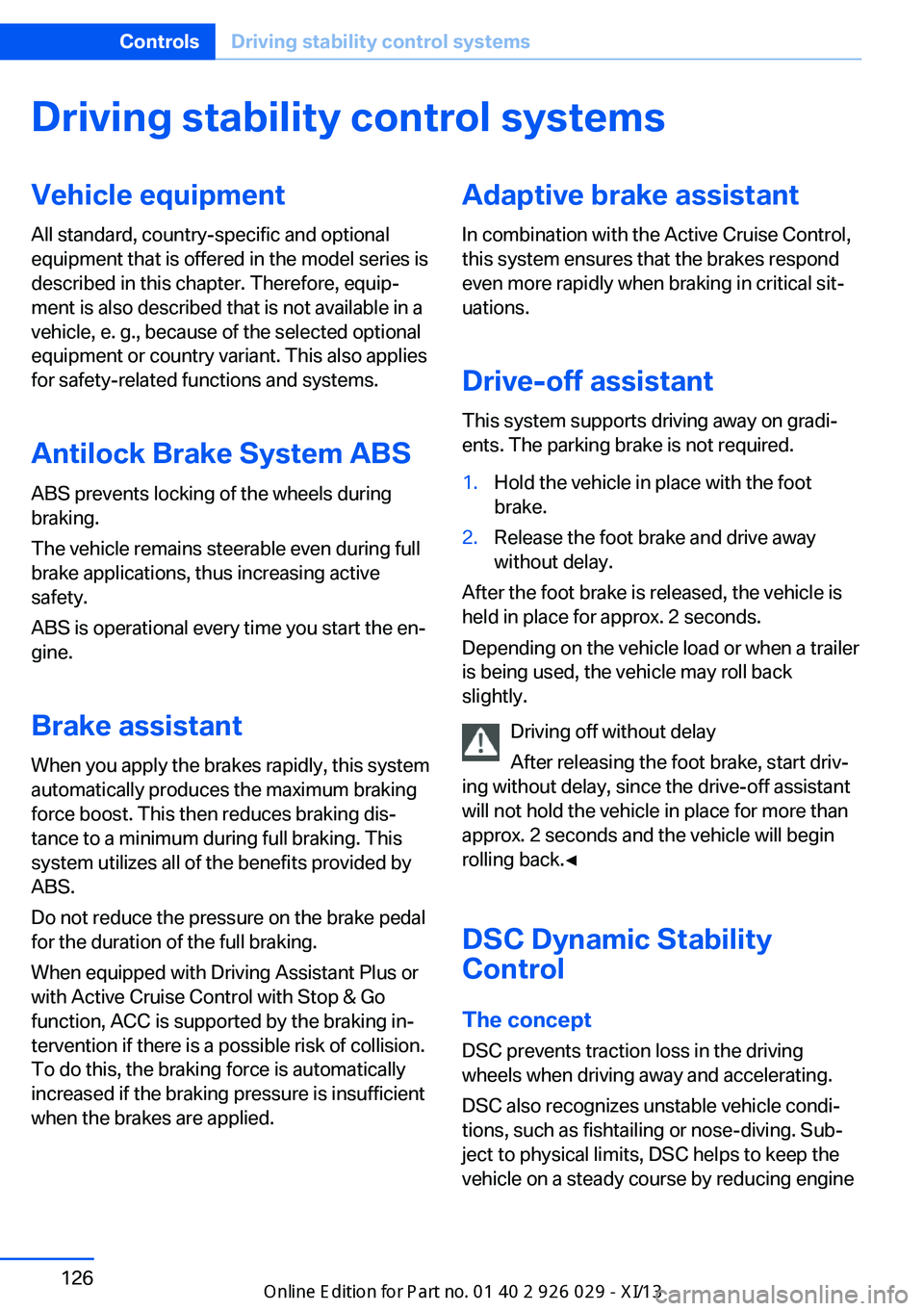
Driving stability control systemsVehicle equipmentAll standard, country-specific and optional
equipment that is offered in the model series is
described in this chapter. Therefore, equip‚Äź
ment is also described that is not available in a
vehicle, e. g., because of the selected optional
equipment or country variant. This also applies
for safety-related functions and systems.
Antilock Brake System ABS ABS prevents locking of the wheels during
braking.
The vehicle remains steerable even during full
brake applications, thus increasing active
safety.
ABS is operational every time you start the en‚Äź
gine.
Brake assistant
When you apply the brakes rapidly, this system
automatically produces the maximum braking
force boost. This then reduces braking dis‚Äź tance to a minimum during full braking. This
system utilizes all of the benefits provided by ABS.
Do not reduce the pressure on the brake pedal
for the duration of the full braking.
When equipped with Driving Assistant Plus or
with Active Cruise Control with Stop & Go
function, ACC is supported by the braking in‚Äź
tervention if there is a possible risk of collision.
To do this, the braking force is automatically increased if the braking pressure is insufficient
when the brakes are applied.Adaptive brake assistant
In combination with the Active Cruise Control,
this system ensures that the brakes respond
even more rapidly when braking in critical sit‚Äź
uations.
Drive-off assistant
This system supports driving away on gradi‚Äź
ents. The parking brake is not required.1.Hold the vehicle in place with the foot
brake.2.Release the foot brake and drive away
without delay.
After the foot brake is released, the vehicle is
held in place for approx. 2 seconds.
Depending on the vehicle load or when a trailer
is being used, the vehicle may roll back
slightly.
Driving off without delay
After releasing the foot brake, start driv‚Äź
ing without delay, since the drive-off assistant
will not hold the vehicle in place for more than
approx. 2 seconds and the vehicle will begin
rolling back.‚óÄ
DSC Dynamic Stability
Control
The concept DSC prevents traction loss in the driving
wheels when driving away and accelerating.
DSC also recognizes unstable vehicle condi‚Äź
tions, such as fishtailing or nose-diving. Sub‚Äź
ject to physical limits, DSC helps to keep the
vehicle on a steady course by reducing engine
Seite 126ControlsDriving stability control systems126
Online Edition for Part no. 01 40 2 911 177 - VI/13
Page 157 of 273
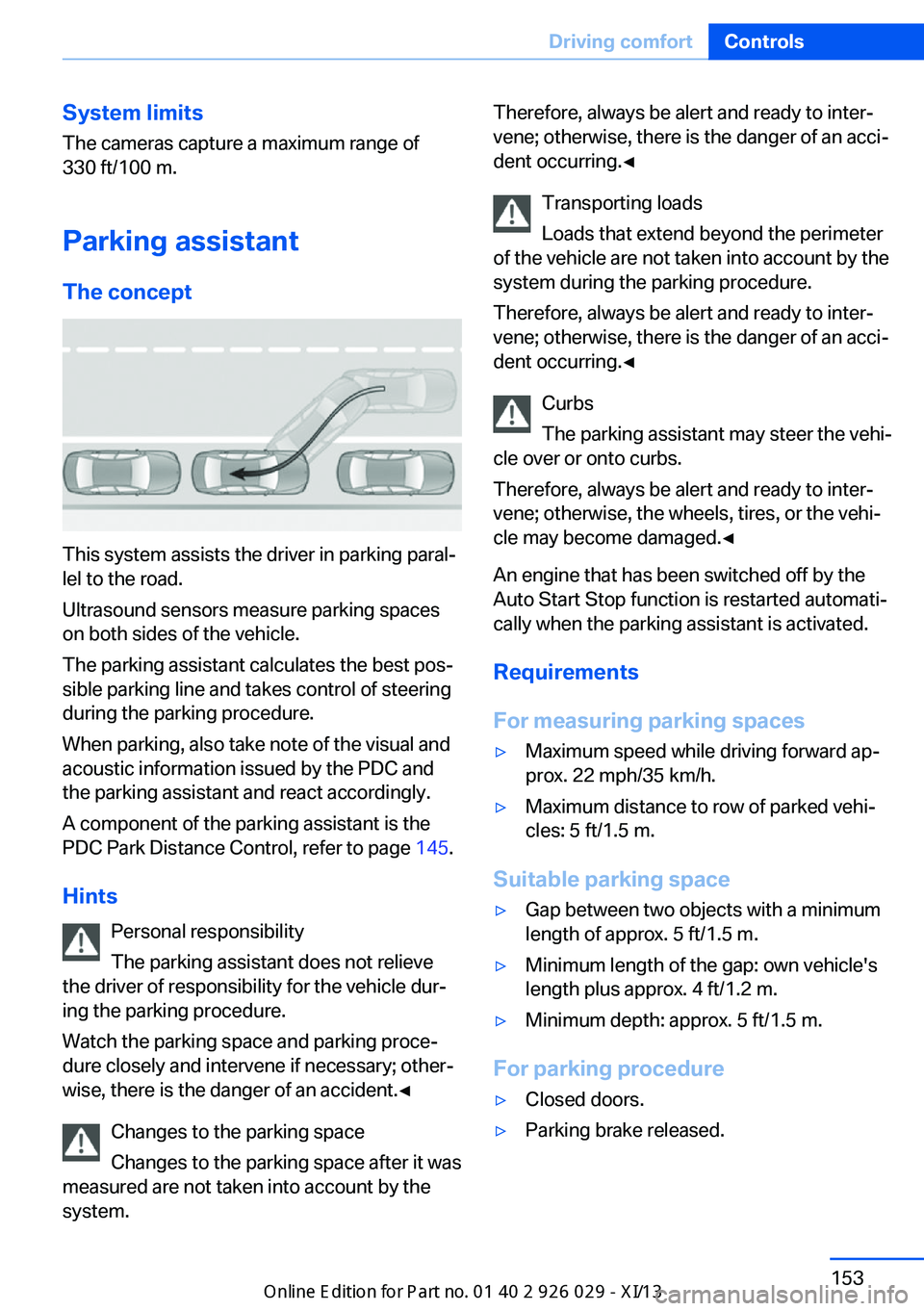
System limits
The cameras capture a maximum range of
330 ft/100 m.
Parking assistantThe concept
This system assists the driver in parking paral‚Äź
lel to the road.
Ultrasound sensors measure parking spaces
on both sides of the vehicle.
The parking assistant calculates the best pos‚Äź
sible parking line and takes control of steering
during the parking procedure.
When parking, also take note of the visual and
acoustic information issued by the PDC and
the parking assistant and react accordingly.
A component of the parking assistant is the
PDC Park Distance Control, refer to page 145.
Hints Personal responsibility
The parking assistant does not relieve
the driver of responsibility for the vehicle dur‚Äź
ing the parking procedure.
Watch the parking space and parking proce‚Äź
dure closely and intervene if necessary; other‚Äź
wise, there is the danger of an accident.‚óÄ
Changes to the parking space
Changes to the parking space after it was
measured are not taken into account by the
system.
Therefore, always be alert and ready to inter‚Äź
vene; otherwise, there is the danger of an acci‚Äź
dent occurring.‚óÄ
Transporting loads
Loads that extend beyond the perimeter
of the vehicle are not taken into account by the
system during the parking procedure.
Therefore, always be alert and ready to inter‚Äź
vene; otherwise, there is the danger of an acci‚Äź
dent occurring.‚óÄ
Curbs
The parking assistant may steer the vehi‚Äź
cle over or onto curbs.
Therefore, always be alert and ready to inter‚Äź
vene; otherwise, the wheels, tires, or the vehi‚Äź
cle may become damaged.‚óÄ
An engine that has been switched off by the
Auto Start Stop function is restarted automati‚Äź
cally when the parking assistant is activated.
Requirements
For measuring parking spaces‚Ė∑Maximum speed while driving forward ap‚Äź
prox. 22 mph/35 km/h.‚Ė∑Maximum distance to row of parked vehi‚Äź
cles: 5 ft/1.5 m.
Suitable parking space
‚Ė∑Gap between two objects with a minimum
length of approx. 5 ft/1.5 m.‚Ė∑Minimum length of the gap: own vehicle's
length plus approx. 4 ft/1.2 m.‚Ė∑Minimum depth: approx. 5 ft/1.5 m.
For parking procedure
‚Ė∑Closed doors.‚Ė∑Parking brake released.Seite 153Driving comfortControls153
Online Edition for Part no. 01 40 2 911 177 - VI/13
Page 196 of 273
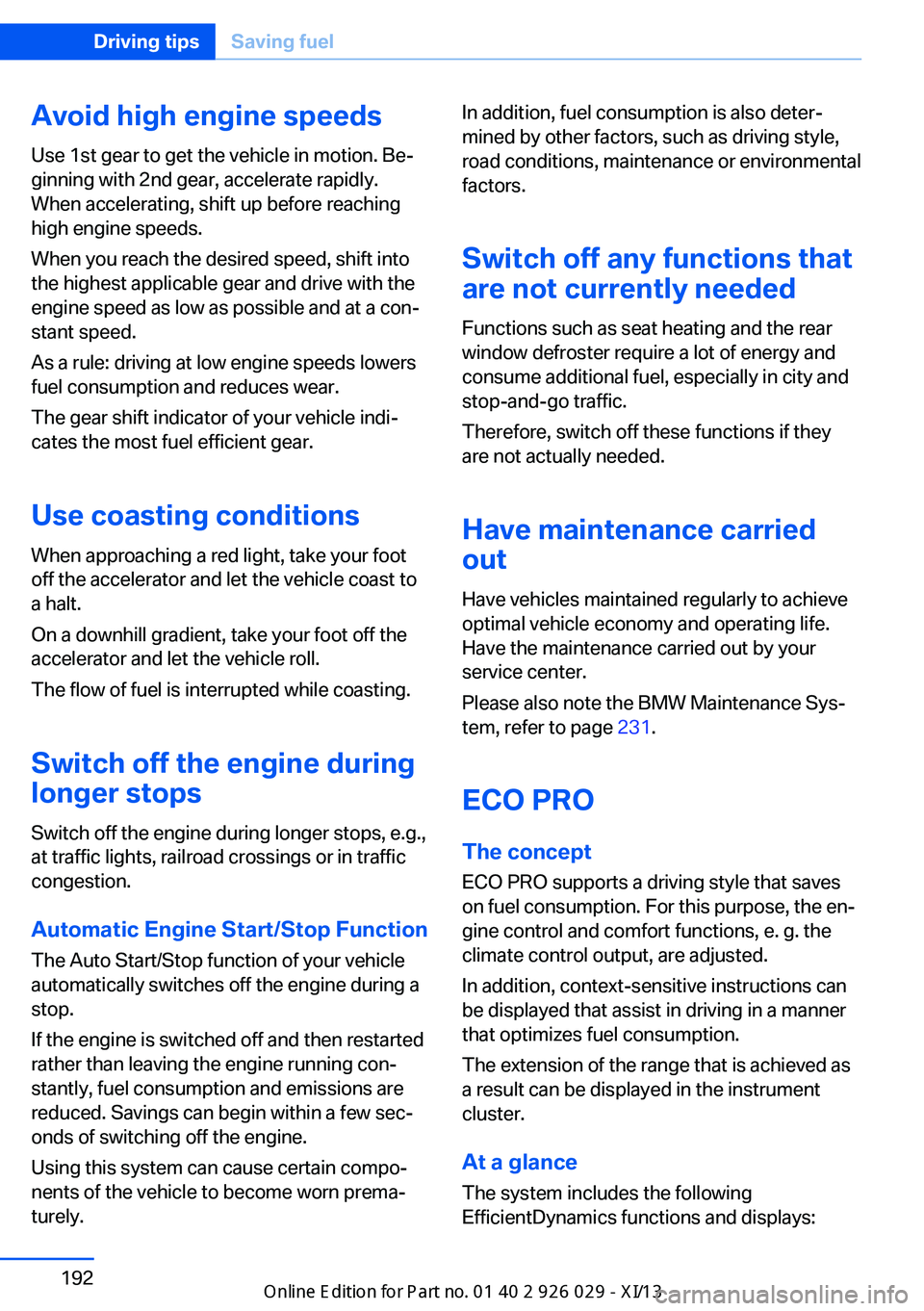
Avoid high engine speeds
Use 1st gear to get the vehicle in motion. Be‚Äź
ginning with 2nd gear, accelerate rapidly.
When accelerating, shift up before reaching
high engine speeds.
When you reach the desired speed, shift into
the highest applicable gear and drive with the
engine speed as low as possible and at a con‚Äź
stant speed.
As a rule: driving at low engine speeds lowers
fuel consumption and reduces wear.
The gear shift indicator of your vehicle indi‚Äź
cates the most fuel efficient gear.
Use coasting conditions When approaching a red light, take your foot
off the accelerator and let the vehicle coast to
a halt.
On a downhill gradient, take your foot off the
accelerator and let the vehicle roll.
The flow of fuel is interrupted while coasting.
Switch off the engine during
longer stops
Switch off the engine during longer stops, e.g.,
at traffic lights, railroad crossings or in traffic
congestion.
Automatic Engine Start/Stop Function
The Auto Start/Stop function of your vehicle
automatically switches off the engine during a
stop.
If the engine is switched off and then restarted
rather than leaving the engine running con‚Äź
stantly, fuel consumption and emissions are
reduced. Savings can begin within a few sec‚Äź
onds of switching off the engine.
Using this system can cause certain compo‚Äź
nents of the vehicle to become worn prema‚Äź
turely.In addition, fuel consumption is also deter‚Äź
mined by other factors, such as driving style,
road conditions, maintenance or environmental
factors.
Switch off any functions that
are not currently needed
Functions such as seat heating and the rear
window defroster require a lot of energy and
consume additional fuel, especially in city and
stop-and-go traffic.
Therefore, switch off these functions if they
are not actually needed.
Have maintenance carried
out
Have vehicles maintained regularly to achieve
optimal vehicle economy and operating life.
Have the maintenance carried out by your
service center.
Please also note the BMW Maintenance Sys‚Äź
tem, refer to page 231.
ECO PRO
The concept ECO PRO supports a driving style that saves
on fuel consumption. For this purpose, the en‚Äź
gine control and comfort functions, e. g. the
climate control output, are adjusted.
In addition, context-sensitive instructions can
be displayed that assist in driving in a manner
that optimizes fuel consumption.
The extension of the range that is achieved as
a result can be displayed in the instrument
cluster.
At a glance
The system includes the following
EfficientDynamics functions and displays:Seite 192Driving tipsSaving fuel192
Online Edition for Part no. 01 40 2 911 177 - VI/13
Page 199 of 273
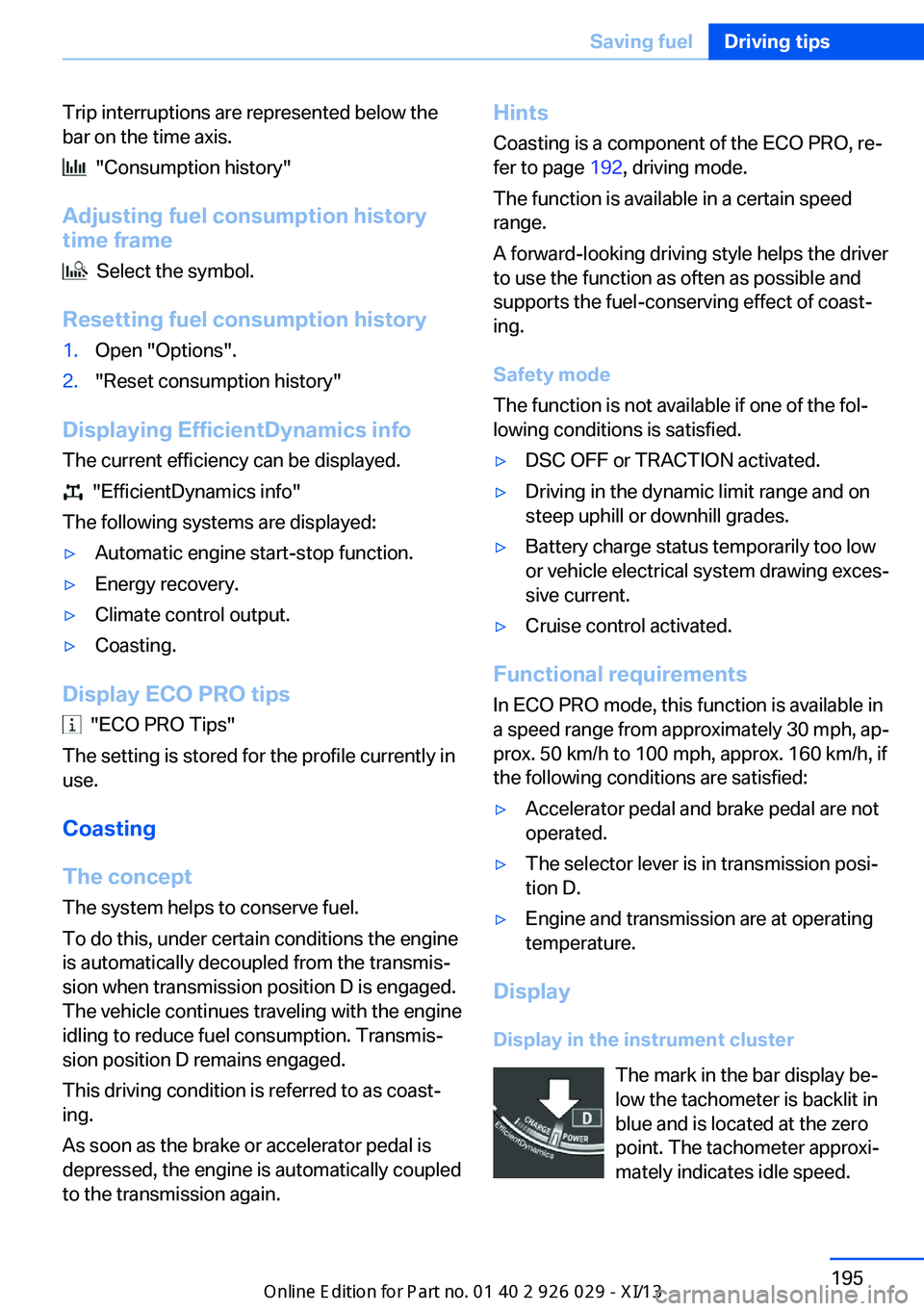
Trip interruptions are represented below the
bar on the time axis.
"Consumption history"
Adjusting fuel consumption history time frame
Select the symbol.
Resetting fuel consumption history
1.Open "Options".2."Reset consumption history"
Displaying EfficientDynamics info
The current efficiency can be displayed.
"EfficientDynamics info"
The following systems are displayed:
‚Ė∑Automatic engine start-stop function.‚Ė∑Energy recovery.‚Ė∑Climate control output.‚Ė∑Coasting.
Display ECO PRO tips
"ECO PRO Tips"
The setting is stored for the profile currently in
use.
Coasting
The concept
The system helps to conserve fuel.
To do this, under certain conditions the engine
is automatically decoupled from the transmis‚Äź
sion when transmission position D is engaged.
The vehicle continues traveling with the engine
idling to reduce fuel consumption. Transmis‚Äź
sion position D remains engaged.
This driving condition is referred to as coast‚Äź
ing.
As soon as the brake or accelerator pedal is
depressed, the engine is automatically coupled
to the transmission again.
Hints
Coasting is a component of the ECO PRO, re‚Äź
fer to page 192, driving mode.
The function is available in a certain speed
range.
A forward-looking driving style helps the driver
to use the function as often as possible and supports the fuel-conserving effect of coast‚Äź
ing.
Safety mode
The function is not available if one of the fol‚Äź
lowing conditions is satisfied.‚Ė∑DSC OFF or TRACTION activated.‚Ė∑Driving in the dynamic limit range and on
steep uphill or downhill grades.‚Ė∑Battery charge status temporarily too low
or vehicle electrical system drawing exces‚Äź
sive current.‚Ė∑Cruise control activated.
Functional requirements
In ECO PRO mode, this function is available in
a speed range from approximately 30 mph, ap‚Äź
prox. 50 km/h to 100 mph, approx. 160 km/h, if
the following conditions are satisfied:
‚Ė∑Accelerator pedal and brake pedal are not
operated.‚Ė∑The selector lever is in transmission posi‚Äź
tion D.‚Ė∑Engine and transmission are at operating
temperature.
Display
Display in the instrument cluster The mark in the bar display be‚Äź
low the tachometer is backlit in
blue and is located at the zero
point. The tachometer approxi‚Äź
mately indicates idle speed.
Seite 195Saving fuelDriving tips195
Online Edition for Part no. 01 40 2 911 177 - VI/13
Page 247 of 273
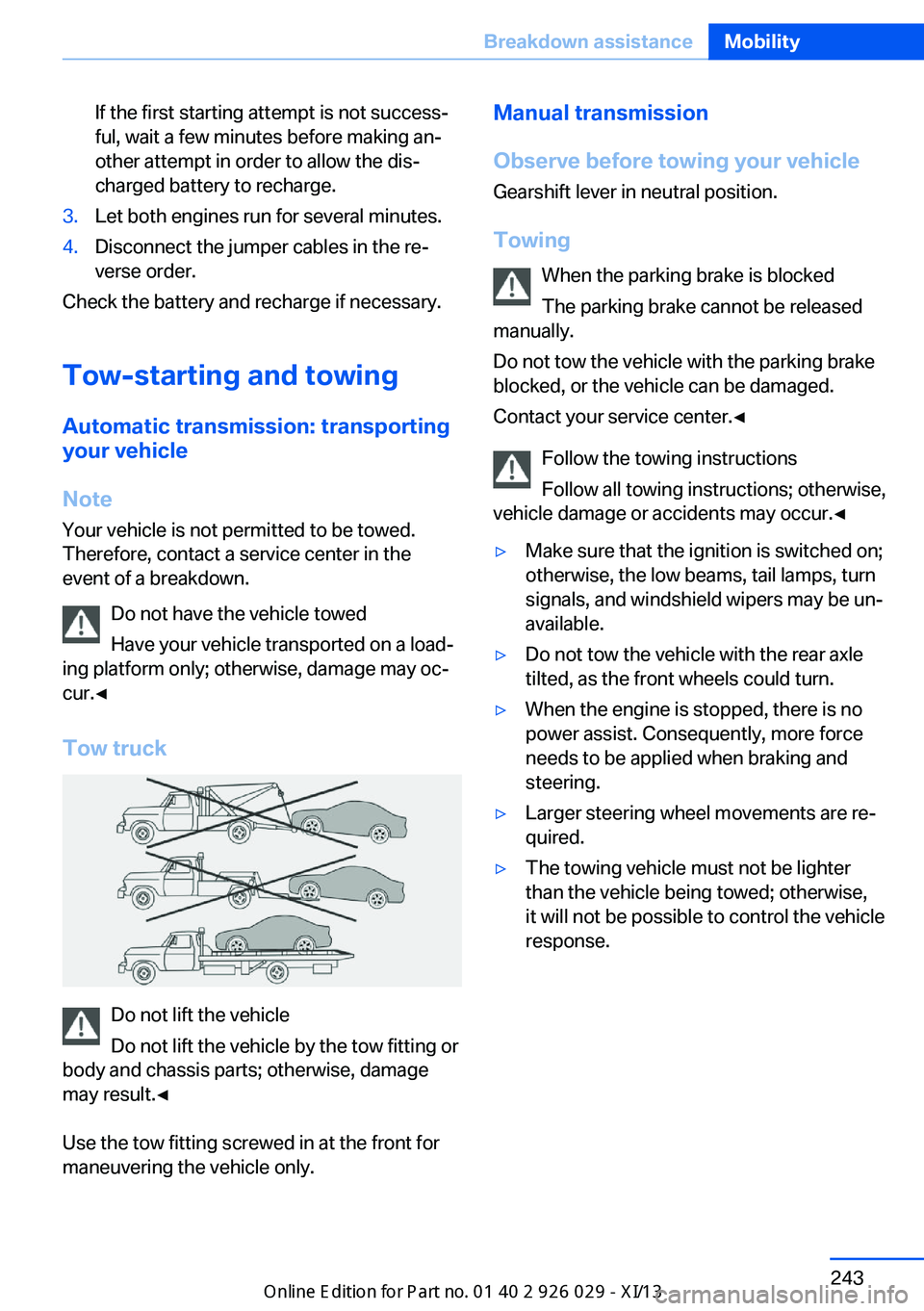
If the first starting attempt is not success‚Äź
ful, wait a few minutes before making an‚Äź
other attempt in order to allow the dis‚Äź
charged battery to recharge.3.Let both engines run for several minutes.4.Disconnect the jumper cables in the re‚Äź
verse order.
Check the battery and recharge if necessary.
Tow-starting and towing Automatic transmission: transporting
your vehicle
Note
Your vehicle is not permitted to be towed.
Therefore, contact a service center in the
event of a breakdown.
Do not have the vehicle towed
Have your vehicle transported on a load‚Äź
ing platform only; otherwise, damage may oc‚Äź
cur.‚óÄ
Tow truck
Do not lift the vehicle
Do not lift the vehicle by the tow fitting or
body and chassis parts; otherwise, damage
may result.‚óÄ
Use the tow fitting screwed in at the front for
maneuvering the vehicle only.
Manual transmission
Observe before towing your vehicle Gearshift lever in neutral position.
Towing When the parking brake is blocked
The parking brake cannot be released
manually.
Do not tow the vehicle with the parking brake
blocked, or the vehicle can be damaged.
Contact your service center.‚óÄ
Follow the towing instructions
Follow all towing instructions; otherwise,
vehicle damage or accidents may occur.‚óÄ‚Ė∑Make sure that the ignition is switched on;
otherwise, the low beams, tail lamps, turn
signals, and windshield wipers may be un‚Äź
available.‚Ė∑Do not tow the vehicle with the rear axle
tilted, as the front wheels could turn.‚Ė∑When the engine is stopped, there is no
power assist. Consequently, more force
needs to be applied when braking and
steering.‚Ė∑Larger steering wheel movements are re‚Äź
quired.‚Ė∑The towing vehicle must not be lighter
than the vehicle being towed; otherwise,
it will not be possible to control the vehicle
response.Seite 243Breakdown assistanceMobility243
Online Edition for Part no. 01 40 2 911 177 - VI/13
Page 249 of 273
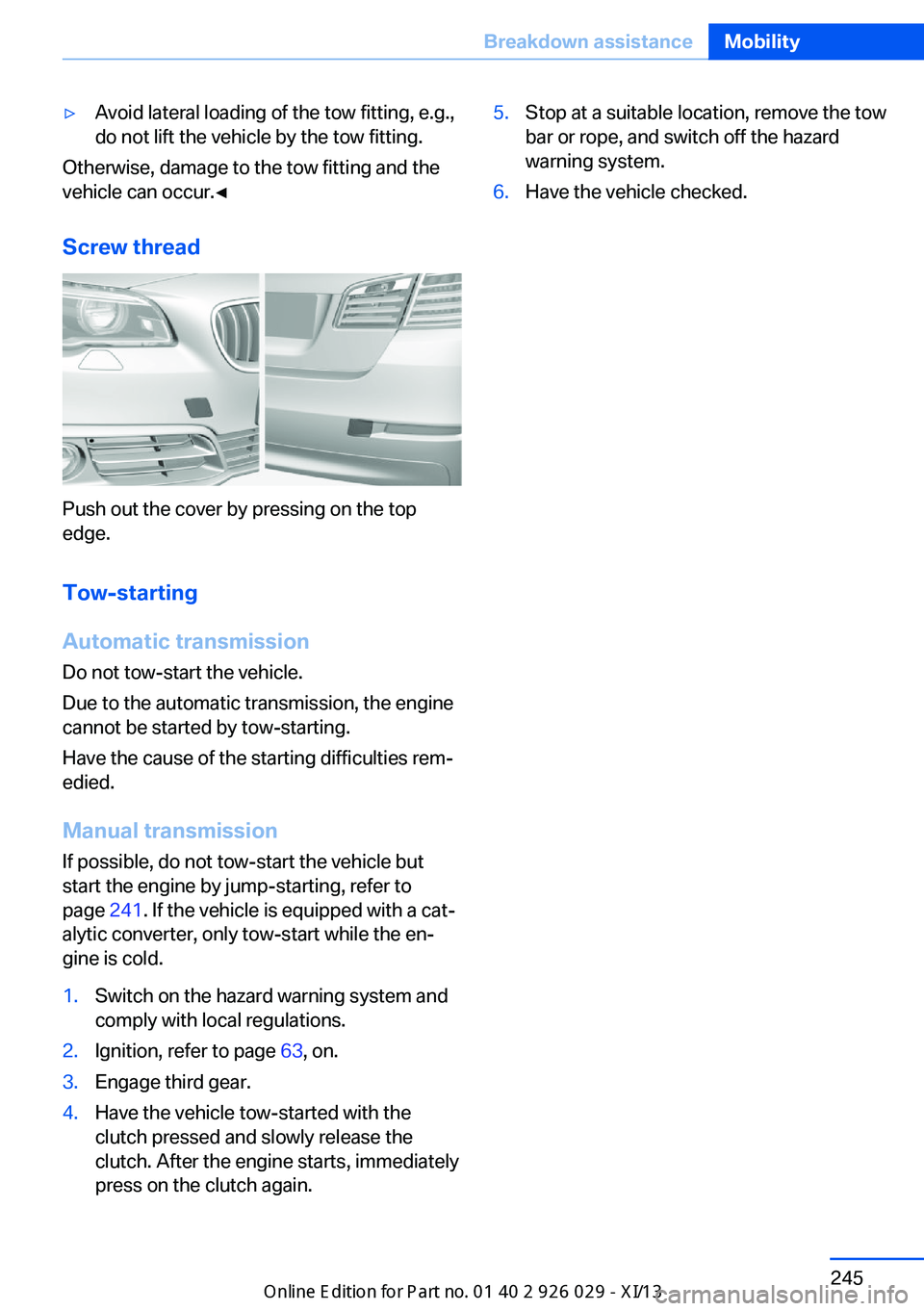
‚Ė∑Avoid lateral loading of the tow fitting, e.g.,
do not lift the vehicle by the tow fitting.
Otherwise, damage to the tow fitting and the
vehicle can occur.‚óÄ
Screw thread
Push out the cover by pressing on the top
edge.
Tow-starting
Automatic transmission Do not tow-start the vehicle.
Due to the automatic transmission, the engine
cannot be started by tow-starting.
Have the cause of the starting difficulties rem‚Äź
edied.
Manual transmission
If possible, do not tow-start the vehicle but
start the engine by jump-starting, refer to
page 241. If the vehicle is equipped with a cat‚Äź
alytic converter, only tow-start while the en‚Äź
gine is cold.
1.Switch on the hazard warning system and
comply with local regulations.2.Ignition, refer to page 63, on.3.Engage third gear.4.Have the vehicle tow-started with the
clutch pressed and slowly release the
clutch. After the engine starts, immediately
press on the clutch again.5.Stop at a suitable location, remove the tow
bar or rope, and switch off the hazard
warning system.6.Have the vehicle checked.Seite 245Breakdown assistanceMobility245
Online Edition for Part no. 01 40 2 911 177 - VI/13
Page 251 of 273
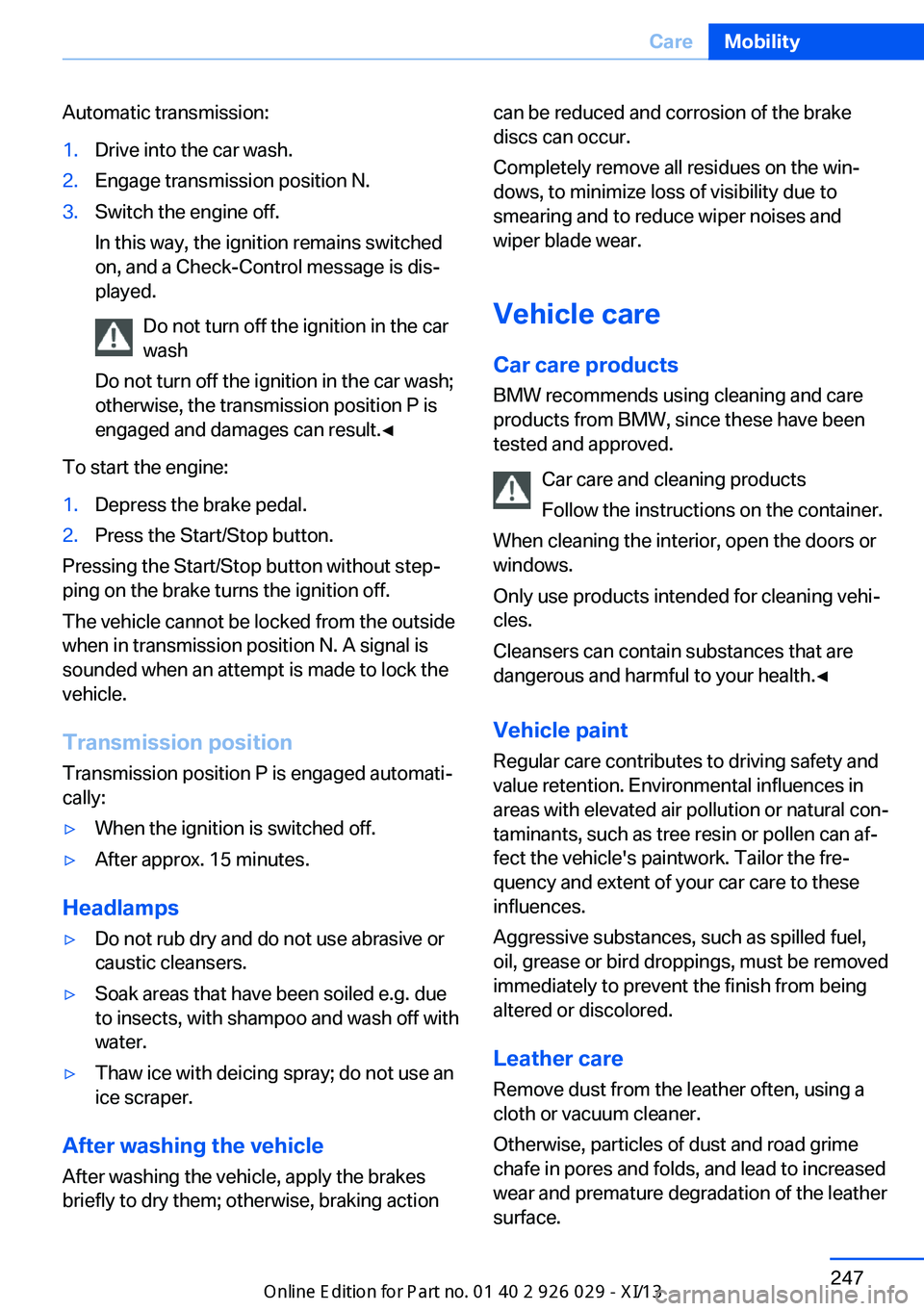
Automatic transmission:1.Drive into the car wash.2.Engage transmission position N.3.Switch the engine off.
In this way, the ignition remains switched
on, and a Check-Control message is dis‚Äź
played.
Do not turn off the ignition in the car
wash
Do not turn off the ignition in the car wash;
otherwise, the transmission position P is
engaged and damages can result.‚óÄ
To start the engine:
1.Depress the brake pedal.2.Press the Start/Stop button.
Pressing the Start/Stop button without step‚Äź
ping on the brake turns the ignition off.
The vehicle cannot be locked from the outside
when in transmission position N. A signal is
sounded when an attempt is made to lock the
vehicle.
Transmission position
Transmission position P is engaged automati‚Äź
cally:
‚Ė∑When the ignition is switched off.‚Ė∑After approx. 15 minutes.
Headlamps
‚Ė∑Do not rub dry and do not use abrasive or
caustic cleansers.‚Ė∑Soak areas that have been soiled e.g. due
to insects, with shampoo and wash off with
water.‚Ė∑Thaw ice with deicing spray; do not use an
ice scraper.
After washing the vehicle
After washing the vehicle, apply the brakes
briefly to dry them; otherwise, braking action
can be reduced and corrosion of the brake
discs can occur.
Completely remove all residues on the win‚Äź
dows, to minimize loss of visibility due to
smearing and to reduce wiper noises and
wiper blade wear.
Vehicle care
Car care products BMW recommends using cleaning and care
products from BMW, since these have been
tested and approved.
Car care and cleaning products
Follow the instructions on the container.
When cleaning the interior, open the doors or
windows.
Only use products intended for cleaning vehi‚Äź
cles.
Cleansers can contain substances that are
dangerous and harmful to your health.‚óÄ
Vehicle paint
Regular care contributes to driving safety and
value retention. Environmental influences in
areas with elevated air pollution or natural con‚Äź
taminants, such as tree resin or pollen can af‚Äź
fect the vehicle's paintwork. Tailor the fre‚Äź
quency and extent of your car care to these
influences.
Aggressive substances, such as spilled fuel,
oil, grease or bird droppings, must be removed
immediately to prevent the finish from being
altered or discolored.
Leather care
Remove dust from the leather often, using a
cloth or vacuum cleaner.
Otherwise, particles of dust and road grime
chafe in pores and folds, and lead to increased
wear and premature degradation of the leather
surface.Seite 247CareMobility247
Online Edition for Part no. 01 40 2 911 177 - VI/13
Page 262 of 273
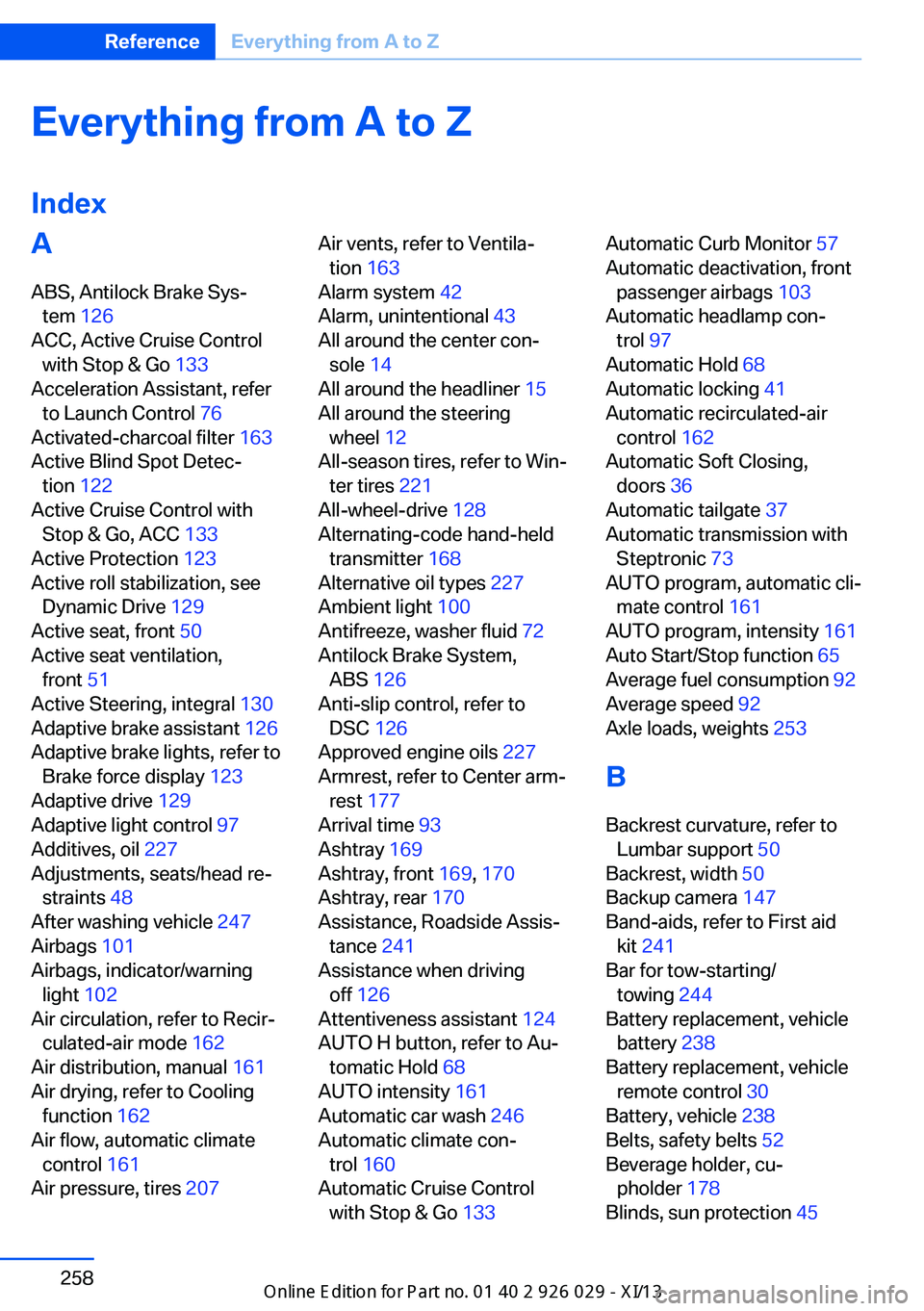
Everything from A to Z
IndexA ABS, Antilock Brake Sys‚Äź tem 126
ACC, Active Cruise Control with Stop & Go 133
Acceleration Assistant, refer to Launch Control 76
Activated-charcoal filter 163
Active Blind Spot Detec‚Äź tion 122
Active Cruise Control with Stop & Go, ACC 133
Active Protection 123
Active roll stabilization, see Dynamic Drive 129
Active seat, front 50
Active seat ventilation, front 51
Active Steering, integral 130
Adaptive brake assistant 126
Adaptive brake lights, refer to Brake force display 123
Adaptive drive 129
Adaptive light control 97
Additives, oil 227
Adjustments, seats/head re‚Äź straints 48
After washing vehicle 247
Airbags 101
Airbags, indicator/warning light 102
Air circulation, refer to Recir‚Äź culated-air mode 162
Air distribution, manual 161
Air drying, refer to Cooling function 162
Air flow, automatic climate control 161
Air pressure, tires 207 Air vents, refer to Ventila‚Äź
tion 163
Alarm system 42
Alarm, unintentional 43
All around the center con‚Äź sole 14
All around the headliner 15
All around the steering wheel 12
All-season tires, refer to Win‚Äź ter tires 221
All-wheel-drive 128
Alternating-code hand-held transmitter 168
Alternative oil types 227
Ambient light 100
Antifreeze, washer fluid 72
Antilock Brake System, ABS 126
Anti-slip control, refer to DSC 126
Approved engine oils 227
Armrest, refer to Center arm‚Äź rest 177
Arrival time 93
Ashtray 169
Ashtray, front 169, 170
Ashtray, rear 170
Assistance, Roadside Assis‚Äź tance 241
Assistance when driving off 126
Attentiveness assistant 124
AUTO H button, refer to Au‚Äź tomatic Hold 68
AUTO intensity 161
Automatic car wash 246
Automatic climate con‚Äź trol 160
Automatic Cruise Control with Stop & Go 133 Automatic Curb Monitor 57
Automatic deactivation, front passenger airbags 103
Automatic headlamp con‚Äź trol 97
Automatic Hold 68
Automatic locking 41
Automatic recirculated-air control 162
Automatic Soft Closing, doors 36
Automatic tailgate 37
Automatic transmission with Steptronic 73
AUTO program, automatic cli‚Äź mate control 161
AUTO program, intensity 161
Auto Start/Stop function 65
Average fuel consumption 92
Average speed 92
Axle loads, weights 253
B Backrest curvature, refer to Lumbar support 50
Backrest, width 50
Backup camera 147
Band-aids, refer to First aid kit 241
Bar for tow-starting/ towing 244
Battery replacement, vehicle battery 238
Battery replacement, vehicle remote control 30
Battery, vehicle 238
Belts, safety belts 52
Beverage holder, cu‚Äź pholder 178
Blinds, sun protection 45 Seite 258ReferenceEverything from A to Z258
Online Edition for Part no. 01 40 2 911 177 - VI/13